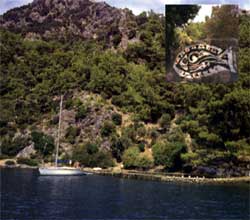 One
of the most important bays in the gulf is Bedri Rahmi Koyu, known by the local
people as Taskaya. Situated opposite Tersane Adasi, this bay was named after the
Turkish writer and artist Bedri Rahmi Eyüpoglu, who was one of the first to
experience a ‘Blue Voyage’ back in 1973. During this pioneer journey, he
painted a picture of a fish on a boulder behind the fountain here. A number of
Turkish intellects and artists such as Bedri Rahmi, his brother Selahattin Eyüpoglu
and Azra Erhat participated on the first ‘Blue Voyage’ and discovered all
this natural beauty. In describing these incredible bays in subsequent newspaper
articles and books, they recommended that everyone experience what eventually
became known as the ‘Blue Voyage.’
One
of the most important bays in the gulf is Bedri Rahmi Koyu, known by the local
people as Taskaya. Situated opposite Tersane Adasi, this bay was named after the
Turkish writer and artist Bedri Rahmi Eyüpoglu, who was one of the first to
experience a ‘Blue Voyage’ back in 1973. During this pioneer journey, he
painted a picture of a fish on a boulder behind the fountain here. A number of
Turkish intellects and artists such as Bedri Rahmi, his brother Selahattin Eyüpoglu
and Azra Erhat participated on the first ‘Blue Voyage’ and discovered all
this natural beauty. In describing these incredible bays in subsequent newspaper
articles and books, they recommended that everyone experience what eventually
became known as the ‘Blue Voyage.’
There is a freshwater fountain under some immense pine trees at the NE end of
this wide bay, which poses no problems as far as entering it is concerned. You
can drop anchor at a depth of 2 —2.5 m. at the spot where a restaurant and a
pier are located, and replenish your water supply at the fountain at the same
time. You can see Bedri Rahmi’s picture of a fish right behind this fountain
and just behind it is a Lycian rock tomb seemingly lurking amongst the trees. In
addition to this tomb, there are numerous Lycian pigeon-hole tombs carved into
the face of a [arge rock. In addition, one can encounter a rock tomb with an
embroidered gate as well as three tombs lying next to each other further on
ahead. These rock tombs are peculiar to the Lycians in that they reflect
examples of their wooden edifices. These rock tombs, of which we have seen
several examples in Caunos, with more to be seen in Fethiye and Myra, date to
the 4th-5th centuries B.C. and belong to the ancient city of Crya, located up on
the hill.
Not much remains of the ancient city of Crya, which is reached by ascending
stairs carved out of the rock. The acropolis, which is located further up, is
surrounded by a polygonal wall which was constructed during an earlier period.
In addition, there is a tower and a cistern located within the acropolis.
Although neither coins nor inscriptions were ever uncovered here, we know from
what was written by the Roman author Pliny that this city was Crya.
It is possible to moor in any part of the bay that offers decent shelter
against wind and which has a small beach to the N. If you drop anchor on the
right side of the restaurant, located inside the bay, you will be protected from
prevailing winds. You can wrap a mooring line around the trunk of a pine or
olive tree and stay in this incomparable bay for as long as you wish and swim in
its clear water.
Due to undercurrent that runs through the bay, ills always sparkling clean.
Moreover, it is said that drinking from the curative spring water fountain
located on the left side of the restaurant, on an empty stomach eliminates
intestinal parasites. The bay, which can easily shelter your yacht, is
surrounded by pine woods and olive groves.
There is another small bay opposite to the small island at the entrance of
Bedri Rahmi Koyu, called Zeyno, which is home to a small beach. It is preferred
for its tranquility and its relative security. Adjacent to Bedri Rahmi Koyu is
Kille Koyu, which has made a remarkable recovery from the fires of four years
ago.
 One
of the most important bays in the gulf is Bedri Rahmi Koyu, known by the local
people as Taskaya. Situated opposite Tersane Adasi, this bay was named after the
Turkish writer and artist Bedri Rahmi Eyüpoglu, who was one of the first to
experience a ‘Blue Voyage’ back in 1973. During this pioneer journey, he
painted a picture of a fish on a boulder behind the fountain here. A number of
Turkish intellects and artists such as Bedri Rahmi, his brother Selahattin Eyüpoglu
and Azra Erhat participated on the first ‘Blue Voyage’ and discovered all
this natural beauty. In describing these incredible bays in subsequent newspaper
articles and books, they recommended that everyone experience what eventually
became known as the ‘Blue Voyage.’
One
of the most important bays in the gulf is Bedri Rahmi Koyu, known by the local
people as Taskaya. Situated opposite Tersane Adasi, this bay was named after the
Turkish writer and artist Bedri Rahmi Eyüpoglu, who was one of the first to
experience a ‘Blue Voyage’ back in 1973. During this pioneer journey, he
painted a picture of a fish on a boulder behind the fountain here. A number of
Turkish intellects and artists such as Bedri Rahmi, his brother Selahattin Eyüpoglu
and Azra Erhat participated on the first ‘Blue Voyage’ and discovered all
this natural beauty. In describing these incredible bays in subsequent newspaper
articles and books, they recommended that everyone experience what eventually
became known as the ‘Blue Voyage.’